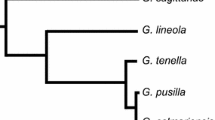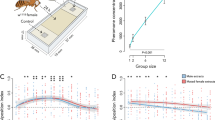Abstract
Parasitoids that forage for herbivorous hosts by using infochemicals may have a problem concerning the reliability and detectability of these stimuli: host stimuli are highly reliable but not very detectable at a distance, while stimuli from the host's food are very detectable but generally not very reliable in indicating host presence. One solution to this problem is to learn to link highly detectable stimuli to reliable but not very detectable stimuli. Ample knowledge is available on how associative learning aids foraging parasitoids in the location of suitable microhabitats. However, in this paper we report on another solution to the reliability-detectability problem and present evidence for an essential, but as yet overlooked, aspect of Drosophila parasitoid ecology. For the first time it is shown that a parasitoid of Drosophila larvae spies on the communication system of adult Drosophila flies to locate potential host sites: naive parasitoids strongly respond to a volatile aggregation pheromone that is deposited in the oviposition site by recently mated female flies. Thus, the parasitoids resort to using highly detectable information from a host stage different from the one under attack (i.e. infochemical detour). The function and ecological implications of these findings are discussed.
Similar content being viewed by others
References
Bartelt RJ, Schaner AM, Jackson LL (1985) cis-Vaccenyl acetate as an aggregation pheromone in Drosophila melanogaster. J Chem Ecol 11: 1747–1756
Dicke M, van Lenteren JC, Boskamp GFJ van Dongen-van Leeuwen E (1984) Chemical stimuli in host-habitat location by Leptopilina heterotoma (Thompson) (Hymenoptera: Eucoilidae) a parasite of Drosophila. J Chem Ecol 10: 695–712
Hardie J, Nottingham SF, Powell W, Wadhams LJ (1991) Synthetic aphid sex pheromone lures female parasitoids. Entomol Exp Appl 61: 97–99
Janssen A (1989) Optimal host selection by Drosophila parasitoids in the field. Funct Ecol 3: 469–479
Janssen A, Driessen G, de Haan M, Roodbol N (1988) The impact of parasitoids on natural populations of temporate woodland Drosophila. Neth J Zool 38: 61–73
Kennedy BH (1979) The effect of multilure on parasites of the European elm bark beetle, Scolytus multistriatus. Bull Entomol Soc Am 25: 116–118
Lewis WJ, Nordlund DA, Gueldner RC, Teal PEA, Tumlinson JH (1982) Kairomones and their use for management of entomophagous insects. XIII. Kairomonal activity for Trichogramma spp. of abdominal tips, excretion, and a synthetic sex pheromone blend of Heliothis zea (Boddie) moths. J Chem Ecol 8: 1323–1331
Noldus LPJJ (1989) Semiochemicals, foraging behaviour and quality of entomophagous insects for biological control J Appl Entomol 108: 425–451
Nordlund DA, Jones RL, Lewis WJ (eds) (1981) Semiochemicals, their role in pest control, Wiley, New York
Papaj DR, Vet LEM (1990) Odour learning and foraging success in the parasitoid, Leptopilina heterotoma. J Chem Ecol 16: 3137–3150
Read DP, Feeny PP, Root RB (1970) Habitat selection by the aphid parasite Charips brassicae (Hymenoptera: Cynipidae). Can Entomol 102: 1567–1578
Schaner AM, Bartelt RJ, Jackson LL (1987) (Z)-11-octadecenyl acetate, an aggregation pheromone in Drosophila simulans. J Chem Ecol 13: 1777–1786
Schaner AM, Graham KJ, Jackson LL (1989a) Aggregation pheromone characterization and comparison in Drosophila ananassae and Drosophila bipectinata. J Chem Ecol 13: 1045–1055
Schaner AM, Benner AM, Leu RD, Jackson LL (1989b) Aggregation pheromone of Drosophila mauritiana, Drosophila yakuba, and Drosophila rajasekari. J Chem Ecol 15: 1249–1257
Shorrocks B, Charlesworth P (1982) A field study of the association between the stinkhorn Phallus impudicus pers. and the British fungal-breeding Drosophila. Biol J Linn Soc 17: 307–318
Spieth HT (1974) Courtship behaviour in Drosophila. Annu Rev Entomol 19: 385–405
Tieleman WC (1988) Substraatpreferentie van Leptopilina heterotoma, L. clavipes en L. fimbriata. MSc thesis, Department of Entomology, Agricultural University Wageningen, Department of Population Biology, University of Leiden.
Van Alphen JJM, Nordlander G, Eijs I (1991) Host habitat finding and host selection of the Drosophila parasitoid Leptopilina australis (Hymenoptera, Eucoilidae) with a comparison of the niches of European Leptopilina species. Oecologia 87: 324–329
Vet LEM (1988) The influence of learning on habitat location and acceptance by parasitoids. Colloq INRA 48: 29–34
Vet LEM, Dicke M (1992) Ecology of infochemical use by natural enemies in a tritrophic context. Annu Rev Entomol 37: 141–172
Vet LEM, Groenewold AW (1990) Semiochemicals and learning in parasitoids. J Chem Ecol 16: 3119–3135
Vet LEM, van Opzeeland K (1985) Olfactory microhabitat selection in Leptopilina heterotoma (Thomson) (Hym.: Eucoilidae), a parasitoid of Drosophilidae. Neth J Zool 35: 497–504
Vet LEM, Wäckers FL, Dicke M (1991) How to hunt for hiding hosts: the reliability-detectability problem in foraging parasitoids. Neth J Zool 41: 202–214
Vinson SB (1976) Host selection by insect parasitoids. Annu Rev Entomol 21: 109–134
Author information
Authors and Affiliations
Rights and permissions
About this article
Cite this article
Wiskerke, J.S.C., Dicke, M. & Vet, L.E.M. Larval parasitoid uses aggregation pheromone of adult hosts in foraging behaviour: a solution to the reliability-detectability problem. Oecologia 93, 145–148 (1993). https://doi.org/10.1007/BF00321204
Received:
Accepted:
Issue Date:
DOI: https://doi.org/10.1007/BF00321204




